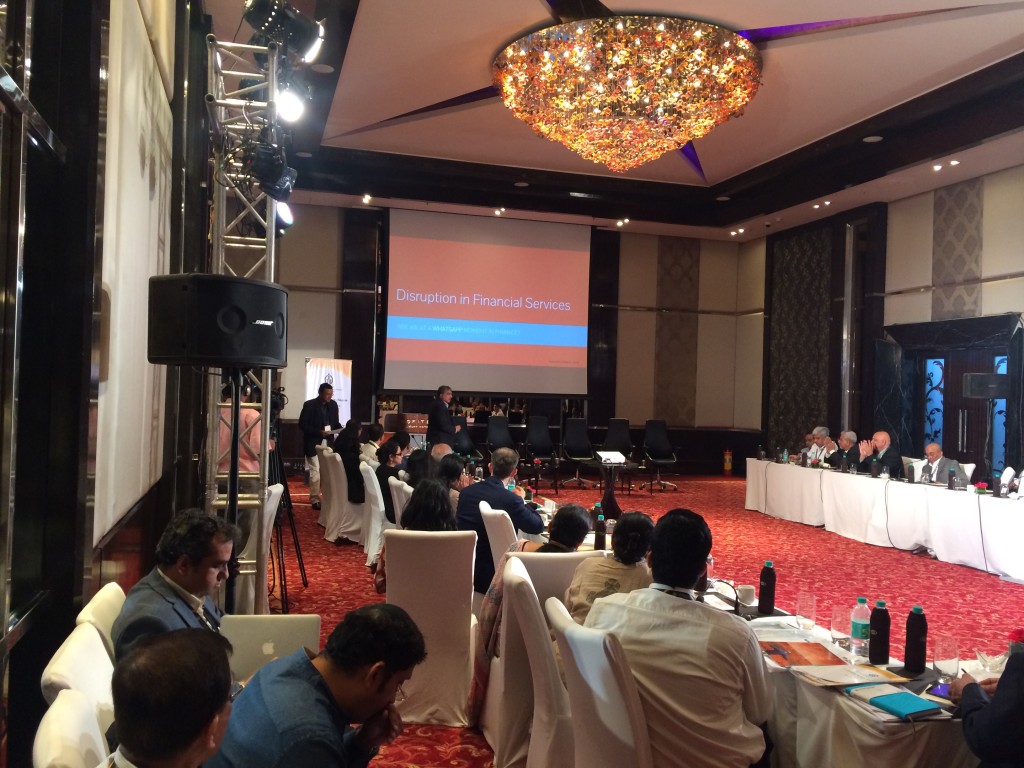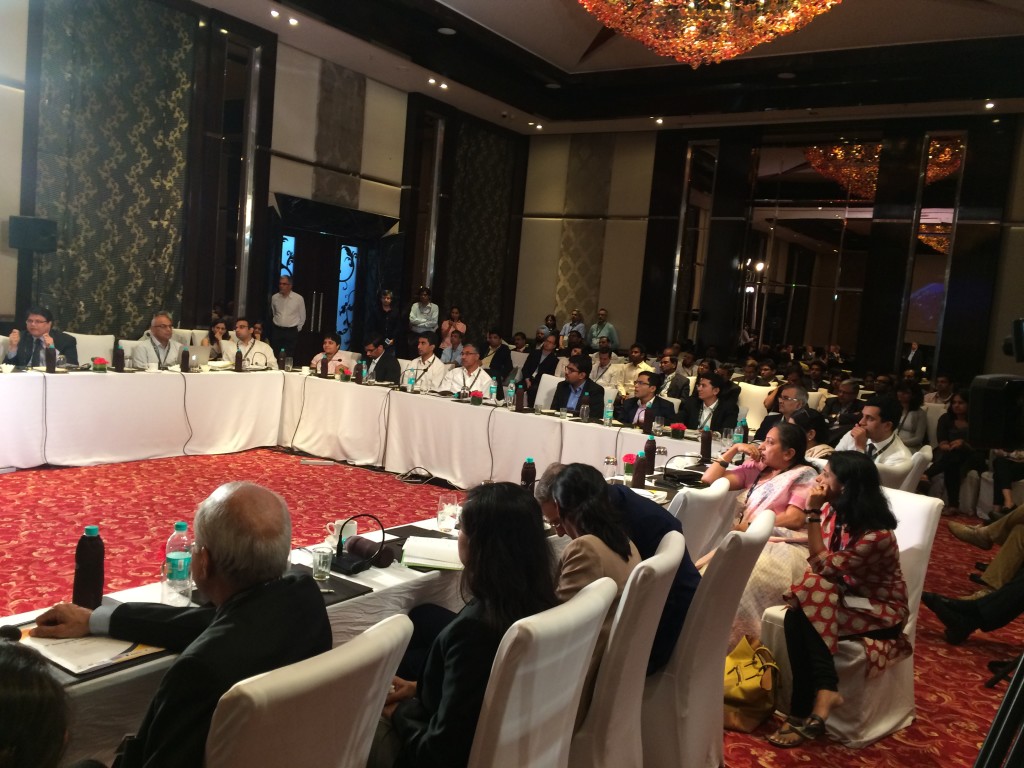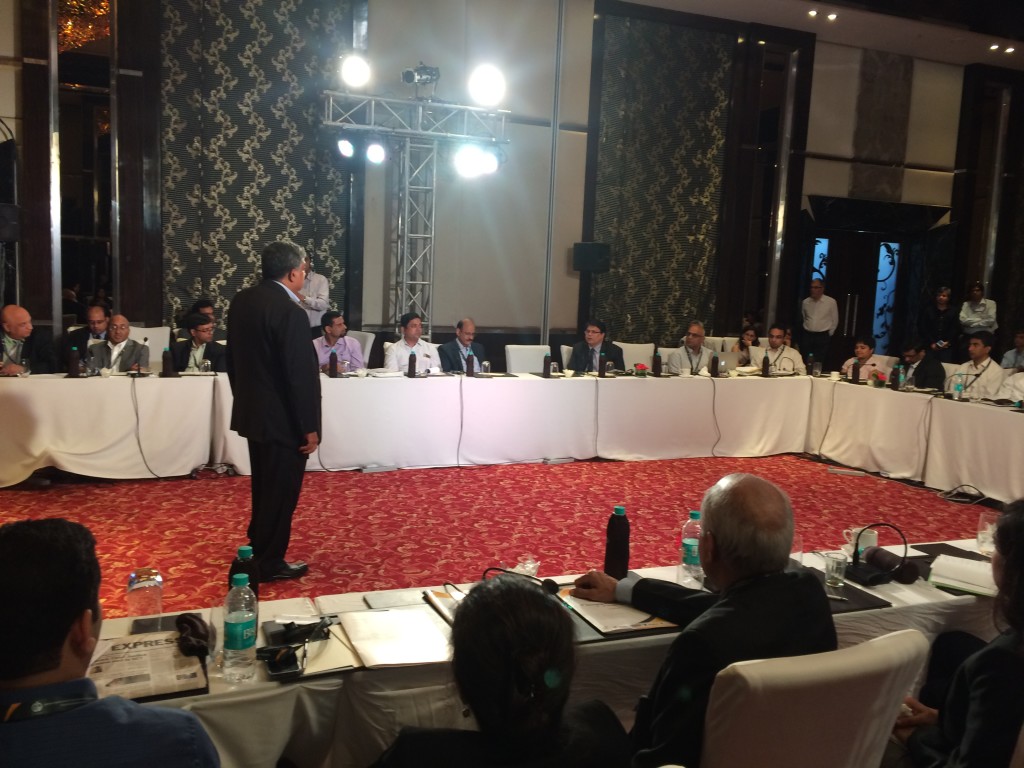IGIDR Finance Research Group partnered with iSPIRT to help conduct a Fintech Session in their 6th edition of Emerging Markets Finance (EMF) Conference held at Sofitel, BKC – Mumbai. The chosen theme for the Fintech Session was “Financial Services to come”. The session was divided into two parts – (1) inform the disruptions in financial services together with the showcase of select software product companies that are offering products leveraging these disruptive influences, and (2) panel discussions to get thought leaderships on the disruptions in payments, including the role of the regulators.
Mr. Nandan Nilekani delivered the keynote address and he enthralled the audience in his inimitable style. His session started by giving insights into the influences driving the disruptions in financial services, including a real-time demo of one such influence i.e. eKYC using Aadhaar. He then took the audience on a journey of how software product companies are leveraging these influences to introduce innovative business models that would fundamentally change the way financial services are conceived and delivered, laying stress on cashless payments. Nandan, not only, laid stress on the current but also gave the audience a glimpse of the possibilities.
 The keynote address was followed by sessions and demos by four select software product companies that have introduced innovative products and / or business models leveraging these influences and making the ‘new’ Fintech happen.
The keynote address was followed by sessions and demos by four select software product companies that have introduced innovative products and / or business models leveraging these influences and making the ‘new’ Fintech happen.
The second half of the Fintech session was designed as panel discussions to engage thought leaders and first movers on their perspectives of these disruptions.
The first panel discussion was on Future of payments, moderated by Sanjay Jain (Volunteer, iSpirt). The discussion was wide ranging, with Mr. A P Hota (MD and CEO, National Payments Corporation of India) providing us the perspective on the infrastructure that has been setup by the NPCI to interconnect banks, which is the basis for payments in India, and Mr. G V Nageswara Rao (MD and CEO, NSDL) on how Payment Banks will bring in technology led business models and change the way payments are done in India. Prof. Bhagwan Chowdhry (Professor, UCLA Anderson School of Management), and David Katz (Deputy Head, Global Govt. Relations at Paypal) brought an international perspective to the panel. The conversation included perspectives on how transaction costs, and the removal of friction play an important role in the growth of digital payments and the move to a cash less society.
 The panel where status quo meets disruption was highly animated discussion led by Prof Phatak and with two participants from the startup/VC community – Haresh Chawla from IVFA & Sanjay Swamy from Prime Ventures – Dr Ajay Shah and Anand Bajaj, Head of Innovation at YesBank. Dr Phatak opened by stating the time is ripe for disruption and to move to a cashless and cardless world of mobile only payments. Mr Chawla was of the view that innovations will come once the cost of moving money between accounts is near zero – and the next wave of innovations will be around applications of low cost payments. Dr Shah was of the view that the regulator still needs to encourage disruptions and remains a risk to the innovation ecosystem if they stop innovations. Mr Bajaj, fresh from the signing of the MOU between YesBank and iSpirt to setup a framework for a banking app store reiterated the bank’s desire to partner with the startups as they innovate. Mr Swamy called for the need to remove some of the obstacles in on-boarding customers for electronic payment acceptance, and asked for a framework for piloting new concepts. Overall the panel raised several real issues that were actively debated – questions from the audience also echoed the fact that most of the points raised were relevant and real issues. Over the coming months we hope the banking industry will address these issues head-on and SRT the stage for India to maximize the opportunity of the new disruptive technologies from Aadhaar to biometric authentication to IMPS and the Unified Payment Interface.
The panel where status quo meets disruption was highly animated discussion led by Prof Phatak and with two participants from the startup/VC community – Haresh Chawla from IVFA & Sanjay Swamy from Prime Ventures – Dr Ajay Shah and Anand Bajaj, Head of Innovation at YesBank. Dr Phatak opened by stating the time is ripe for disruption and to move to a cashless and cardless world of mobile only payments. Mr Chawla was of the view that innovations will come once the cost of moving money between accounts is near zero – and the next wave of innovations will be around applications of low cost payments. Dr Shah was of the view that the regulator still needs to encourage disruptions and remains a risk to the innovation ecosystem if they stop innovations. Mr Bajaj, fresh from the signing of the MOU between YesBank and iSpirt to setup a framework for a banking app store reiterated the bank’s desire to partner with the startups as they innovate. Mr Swamy called for the need to remove some of the obstacles in on-boarding customers for electronic payment acceptance, and asked for a framework for piloting new concepts. Overall the panel raised several real issues that were actively debated – questions from the audience also echoed the fact that most of the points raised were relevant and real issues. Over the coming months we hope the banking industry will address these issues head-on and SRT the stage for India to maximize the opportunity of the new disruptive technologies from Aadhaar to biometric authentication to IMPS and the Unified Payment Interface.
 This is was the first Fintech event for iSPIRT in Mumbai and it received record registrations. IGIDR FRG event organizers expressed desire to conduct a dedicated event based on the positive feedback received.
This is was the first Fintech event for iSPIRT in Mumbai and it received record registrations. IGIDR FRG event organizers expressed desire to conduct a dedicated event based on the positive feedback received.
Guest Contributed by Surya Kasichainula, 3I Infotech & Volunteer for iSPIRT

